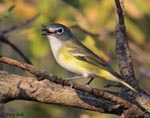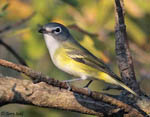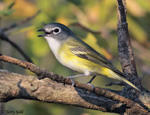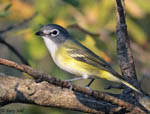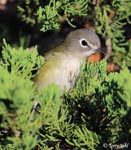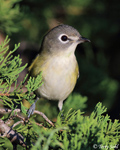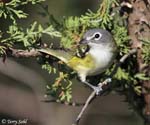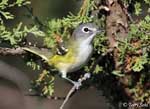Blue-headed Vireo
Vireo solitarius
| Length: 5.25 inches | Wingspan: 8.5 inches | Seasonality: Migrant |
| ID Keys: White "spectacles", two white wing-bars, bluish-gray head, white throat and undersides, olive-green back. | ||
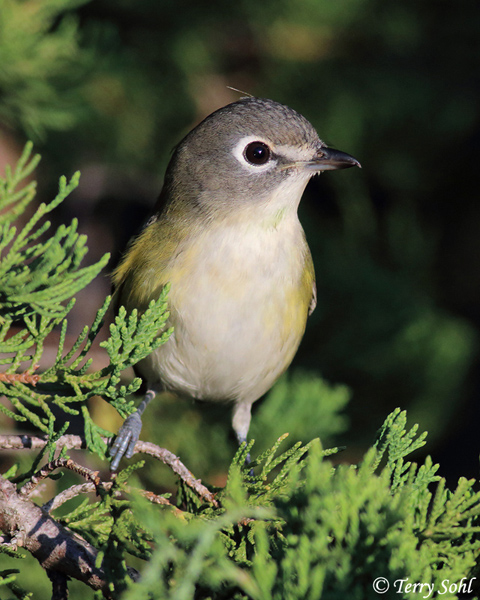 The Blue-headed Vireo, the
Cassin's Vireo, and
the Plumbeous Vireo were all considered
one species, the Solitary Vireo, until the 1990's. The Blue-headed is
the eastern component of the three, migrating throughout the eastern half of
the United States to it's summer destinations in the northeastern U.S. and
Canada. In South Dakota, they're the one of the three species that is found
in the eastern half of the state as they migrate through in both the spring and
the fall. The Plumbeous Vireo (a grayish, less colorful species) is found in the
Black Hills of South Dakota.
The Blue-headed Vireo, the
Cassin's Vireo, and
the Plumbeous Vireo were all considered
one species, the Solitary Vireo, until the 1990's. The Blue-headed is
the eastern component of the three, migrating throughout the eastern half of
the United States to it's summer destinations in the northeastern U.S. and
Canada. In South Dakota, they're the one of the three species that is found
in the eastern half of the state as they migrate through in both the spring and
the fall. The Plumbeous Vireo (a grayish, less colorful species) is found in the
Black Hills of South Dakota.
Habitat:
Blue-headed Vireos use open mixed forests during the summer breeding season. They are the only species of vireo in most of North America that will nest and frequently use conifer/evergreen forests. They area also found in open forests and woodlands during migration and in winter.
Diet:
Primarily feeds on insects and spiders. They will also consume fruits and berries, especially during the winter months.
Behavior:
Primarily forages in the upper portion of trees. They will sometimes observe from a perch and flycatch, flying out to catch passing insects, or clamber along major branches and tree trunks in search of prey.
Breeding:
Non-breeder in South Dakota. In breeding range, the nest is a cup made of grasses, weeds, roots, and moss, lined with downy plant material or animal hair. The female lays 3 to 5 eggs, which are incubated by both parents. Upon hatching, both parents tend to the young, who leave the nest after about 2 weeks.
Song:
Melodic "vireo-like" phrases, slower in pace than other vireo species and with distinct pauses in between each phrase. Blue-headed Vireos also have a chattering, scolding call given in alarm or in defense of a nest site.
- Click here to listen to the Blue-headed Vireo's song1
- Click here to hear a "rambling song" of a Blue-headed Vireo2
- Click here to hear a scolding chatter, and song notes, of a Blue-headed Vireo3
Migration:
Summers in central through southeastern Canada, the Great Lakes Region, New England, and southward through the Appalachians. Winters near the Gulf and Atlantic coasts in the Southeastern United States, as well as Mexico and Central America.
Interactive eBird Map:
Click to access an interactive eBird map of Blue-headed Vireo sightings
Similar Species:
Vireo species can be confusing and Blue-headed Vireo could potentially be confused with the following species:
- Cassin's Vireo - One of the species formerly considered the same species as Blue-headed Vireo, Cassin's Vireo are found in areas nearer the West Coast of North America, and aren't an identification problem in South Dakota. In appearance, the two species are very close, but Cassin's Vireo have less yellowish color on their flanks, and a lesser contrast between the gray head and greenish back than a Blue-headed Vireo.
- Plumbeous Vireo - Plumbeous Vireo were also once considered the same species, and they are found in the Black Hills. Sightings of Blue-headed Vireo in the Black Hills though are extremely rare, however. In appearance, Plumbeous Vireo are less colorful than Blue-headed Vireo, with an overall gray appearance.
- Bell's Vireo - A species found in South Dakota that could cross paths with a Blue-headed Vireo, Bell's Vireo lack the strong "spectacles" look of the Blue-headed Vireo and tend to show less yellowish/greenish tones on the flanks and back. The wingbars on a Bell's Vireo are also paler than those on a Blue-headed Vireo.
- Warbling Vireo - Another species of vireo found in South Dakota, they have a pale eye-stripe that could be confused with the "spectacles" look of a Blue-headed Vireo, but it extends behind the eye. Warbling Vireos lack the wingbars of a Blue-headed Vireo, and tend to have less of a yellowish/greenish wash on the flanks and back.
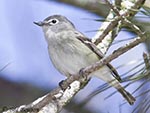 |
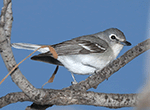 |
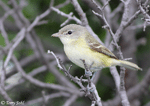 |
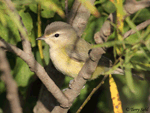 |
| Cassin's Vireo | Plumbeous Vireo | Bell's Vireo | Warbling Vireo |
Conservation Status:
They are quite frequent hosts to cowbird parasitism, and habitat fragmentation makes them more susceptible. However, systematic surveys show substantial population increases over recent decades. They are found across a broad geographic area, and are common in parts of that range. The IUCN lists the Blue-headed Vireo as a species of "Least Concern."
Further Information:
- USGS Patuxent Bird Identification InfoCenter, Blue-headed Vireo
- WhatBird - Blue-headed Vireo
- Audubon Guide - Blue-headed Vireo
Photo Information:
September 2nd, 2012 - Minnehaha County, South Dakota - Terry Sohl
Additional Photos:
Click on the image chips or text links below for additional, higher-resolution Blue-headed Vireo photos.
Audio File Credits:
- 1Jim Berry. Recorded in Cattaraugus County, New York on May 16th, 2020. Original recording and information available from xeno-canto.
- 2Paul Driver. Recorded in Searsport, Maine on July 7th, 2014. Original recording and information available from xeno-canto.
- 2Todd Wilson. Recorded in Waukesha County, Wisconsin on April 18th, 2010. Original recording and information available from xeno-canto.
| Click on the map below for a higher-resolution view |
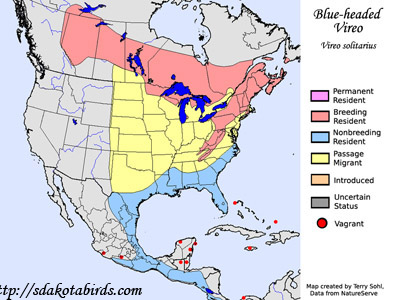 |
| South Dakota Status: Uncommon migrant throughout the state. |
Additional Blue-headed Vireo Photos
Click for a higher-resolution version of these photos
